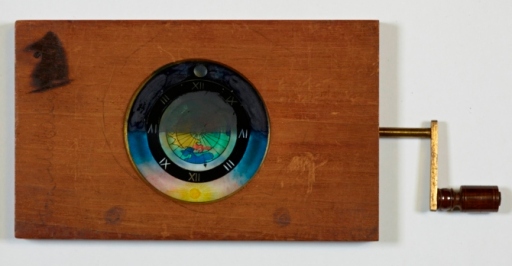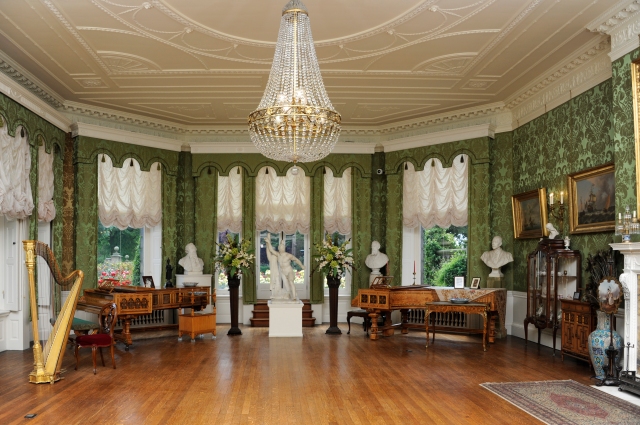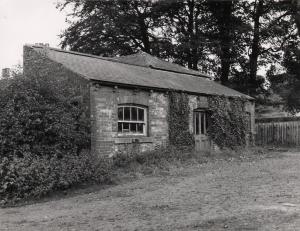
Junior Praestantia Lantern
Photo by Esther Lie
A significant amount of work has been carried out recently on documenting and researching our magic lanterns and slide collections, and it therefore seemed appropriate to reflect this in the 2013 Hidden Histories display. While this Junior Praestantia Lantern might not be as visually interesting as some of the other lanterns in our collection, it demonstrates specific aspects of the history of these instruments and the heritage of the University.
Magic lanterns are considered a predecessor to the modern slide projector. They function by using a condenser lens to focus artificial light (e.g. candle light, limelight or later electric light) onto a glass slide, the light rays then passing through an objective lens system which projects an enlarged version of the slide’s image onto a screen or wall.
The historical development of these instruments dates back to at least the 17th century, with the Dutch scientist Christiaan Huygens often being cited as a key figure in their invention. The peak of their production was during the second-half of the nineteenth century. They provided a popular form of entertainment in both public and domestic settings. Combining slide projection with live narration, music and other special effects, magic lanternists delivered highly successful entertainment spectacles, including phantasmagoria (gathering of ghosts) shows. Slides could have moving parts, and the use of two lanterns in conjunction with pairs of slides could produce ‘dissolving’ (transforming) effects.
It was this ability to produce projection effects that in the days before moving film would have appeared miraculous to audiences that gave magic lanterns this moniker. In scientific or educational settings however it was more common to refer to them as optical lanterns, or simply lanterns. After the moving picture was introduced in the late nineteenth century the popularity of magic lanterns began to decline, but in educational settings their use continued for longer; we think that the use of magic lanterns continued in the Biology department at the University of Leeds until as late as the 1960s. They provided a convenient way of displaying images to a large audience. Ready-made educational slides featuring a wide range of topics could be ordered from catalogues, or lecturers could have them specially produced using images of their own work.
This particular lantern previously belonged to the collection of the Museum of the History of Education which used to exist at the University of Leeds. Before this it was used in lessons at Thornton School in Bradford. It was sold by the Riley Brothers, also of Bradford, who sold lanterns, slides and readings from the 1880s until 1914. The Riley Brothers also gave Bradford its first ever cinema performance on 6th April 1896, at the People’s Palace theatre, on the site where the National Media Museum now stands.

Praestantia Lantern Advert, Ashburton Guardian, 2nd May 1894
‘Praestantia’ is a Latin term used to denote superiority and excellence. While this lantern has previously been dated to 1914, models of this sort were available earlier than this, as evidenced by this newspaper advert from 1894. The advert also shows that it was targeted towards schools and churches, rather than professional entertainers or lecturers in larger educational establishments like Universities, who would use larger lanterns with more complex features.
Educators in the late 19th and early 20th centuries were growing increasingly interested in the value of sensory perception in aiding the process of obtaining and retaining knowledge, and the use of visual aids was common. In school classrooms, a popular way of incorporating these was to give each pupil a lantern slide and ask them to prepare a talk about it, which they delivered while the image was projected. This activity therefore also helped develop oral communication and presentation skills. It was also thought the element of fun provided by this hybrid of entertainment and education would be conducive to learning. This “school-room” method contrasted with the “lecture-room” method, where the slides served as accompanied the instructor’s lecture. In churches, lanterns were used during services or Sunday school classes, to display biblical stories and hymn lyrics, and to warn people of the dangers of various ‘immoral’ activities. They were also popular with travelling missionaries, who could use illustrations on lantern slides as a way of overcoming language barriers.
One of the main reservations schools and small institutions had about using lanterns was the cost involved, and this is addressed in the advertisement above, which emphasises low-prices and the ability to hire equipment or pay in monthly instalments. Other concerns included the need to train teachers how to use this new technology. However, as mentioned in a previous blog post, we think that the particularly successful use of lanterns by professors at the University of Leeds and its predecessor the Yorkshire College may have inspired primary and secondary schools in the area to take up the use of this educational tool with an unusually high level of enthusiasm.
Currently displayed alongside this lantern are two c.1880 rack and pinion turning slides by Newton & Co, London. These coloured slides would have been used to teach pupils and public audiences about phenomena such as the rising and setting of the sun. Turning the handle rotates one sheet of painted glass over the other, moving one part of the slide’s image in relation to the rest and allowing such phenomena to be demonstrated ‘in action’.

Newton & Co rack and pinion slide, c.1880
Digitised by Liz Stainforth
Sources:
Anon. “How to Utilise the Magic Lantern; Some Valuable Hints for Teachers”, The Review of Reviews, May 1890, pg.404
Riley Brothers, “Advertisment: Improved Praestantia Lantern”, Ashburton Guardian, Volume XV, Issue 3268, 2nd May 1894, p.3
Greenacre, D., “Optical Systems in Magic Lanterns”, http://myweb.tiscali.co.uk/magiclantern/optics.html
Newton & Co, “New School Lanterns for Class-Work”, in Newton & Co, Catalogue of Lantern Slides Part II., London, 1906, p.901
Lucerna: The Magic Lantern Web Resource, “Organisation: Riley Brothers, slide manufacturer and dealer”, http://www.slides.uni-trier.de/organisation/index.php?id=1000433
San Diego State University, “Peabody Magic Lantern Collection, Online Presentation”, 2010, http://library.sdsu.edu/exhibits/2009/07/lanterns/index.shtml
Special Collections, J.B. Priestly Library, “The Joseph Riley Archive: Collection Description”, University of Bradford, 2008
University of Leeds Museum of the History of Education Catalogue
Visual Studies Workshop – Exhibition Monograph, “Travels in the Limelight: Projections of the World Through the Magic Lantern, 1880-1930”, in The Magic Lantern Bulletin, Vol. 8, No. 1, April, 1988, pp. 9-12 (http://library.sdsu.edu/pdf/scua/ML_Bulletin/MLBvol18no01.pdf)
Yorkshire Film Archive, “Film No. 3428, Bradford Town Hall Square. Context.”, http://www.yfaonline.com/sites/yorkshirefilmarchive.com/files/node_pdfs/node_7615_context.pdf
For a bibliography of further reading on the use of magic lanterns in education, see The Magic Lantern Bulletin, Vol. 8, No. 1, April, 1988, p. 7. (http://library.sdsu.edu/pdf/scua/ML_Bulletin/MLBvol18no01.pdf)
Further reading on the Riley Brothers:
Copeland, D.M., “Joseph, William, Herbert, Arnold and Bernard Riley”, Who’s Who of Victorian Cinema, http://www.victorian-cinema.net/riley, 2013
Gordon, C., By Gaslight in Winter: A Victorian family history through the magic lantern, London: Elm Tree, 1980
Further blog entries on our lanterns and slides:
https://museumofhstm.wordpress.com/2013/04/30/leeds-a-leading-light-in-lanterns/
https://museumofhstm.wordpress.com/2013/01/14/national-media-museum-magic-lantern-research-trip/
https://museumofhstm.wordpress.com/2012/10/10/beneath-the-scratched-surface-of-a-glass-plate-we-see/
https://museumofhstm.wordpress.com/2012/09/07/magic-lantern-and-light-night-project/








